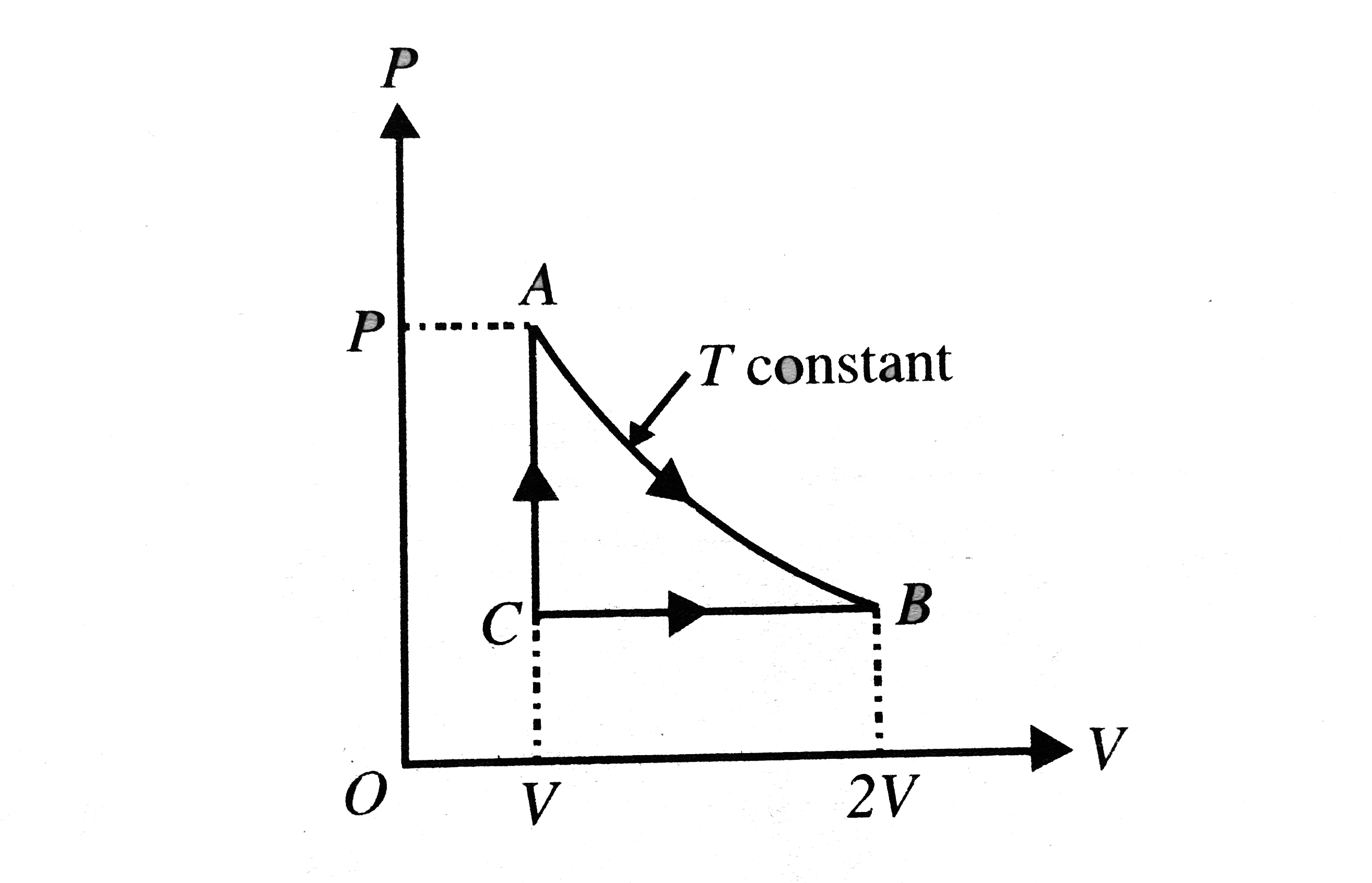Two moles of a gas at temperature T and volume V are heated to twice its volume at constant pressure. If then increase in internal energy of the gas is-
The correct Answer is:B
To find the increase in internal energy of the gas when it is heated at constant pressure, we can follow these steps:
Step 1: Understand the relationship between internal energy, temperature, and heat capacities.
The change in internal energy (ΔU) for an ideal gas can be expressed as:
ΔU=nCvΔT
where n is the number of moles, Cv is the molar heat capacity at constant volume, and ΔT is the change in temperature.
Step 2: Determine the change in temperature (ΔT).
Since the gas is heated at constant pressure and its volume is doubled, we can use the ideal gas law:
PV=nRT
Given that the pressure is constant, if the volume doubles, the temperature must also double. Therefore, if the initial temperature is T, the final temperature Tf will be:
Tf=2T
Thus, the change in temperature is:
ΔT=Tf−T=2T−T=T
Step 3: Relate Cv to Cp using the given ratio CpCv=γ.
From the relationship between heat capacities:
Cp=γCv
We can also use the relation:
Cp−Cv=R
Substituting Cp:
γCv−Cv=R
This simplifies to:
Cv(γ−1)=R
Thus, we can express Cv:
Cv=Rγ−1
Step 4: Substitute Cv and ΔT into the equation for ΔU.
Now substituting Cv and ΔT into the equation for internal energy:
ΔU=nCvΔT=2(Rγ−1)T
This gives us:
ΔU=2RTγ−1
Final Answer:
The increase in internal energy of the gas is:
ΔU=2RTγ−1
The change in internal energy (ΔU) for an ideal gas can be expressed as:
ΔU=nCvΔT
where n is the number of moles, Cv is the molar heat capacity at constant volume, and ΔT is the change in temperature.
Since the gas is heated at constant pressure and its volume is doubled, we can use the ideal gas law:
PV=nRT
Given that the pressure is constant, if the volume doubles, the temperature must also double. Therefore, if the initial temperature is T, the final temperature Tf will be:
Tf=2T
Thus, the change in temperature is:
ΔT=Tf−T=2T−T=T
From the relationship between heat capacities:
Cp=γCv
We can also use the relation:
Cp−Cv=R
Substituting Cp:
γCv−Cv=R
This simplifies to:
Cv(γ−1)=R
Thus, we can express Cv:
Cv=Rγ−1
Now substituting Cv and ΔT into the equation for internal energy:
ΔU=nCvΔT=2(Rγ−1)T
This gives us:
ΔU=2RTγ−1
The increase in internal energy of the gas is:
ΔU=2RTγ−1
Topper's Solved these Questions
- THERMODYNAMICSBOOK - AAKASH INSTITUTE ENGLISHCHAPTER - THERMODYNAMICSEXERCISE - ASSIGNMENT (SECTION -C) (Previous Year Questions)
63 Videos
- THERMODYNAMICSBOOK - AAKASH INSTITUTE ENGLISHCHAPTER - THERMODYNAMICSEXERCISE - ASSIGNMENT (SECTION -D) (Assertion - Reason Type Questions)
10 Videos
- THERMODYNAMICSBOOK - AAKASH INSTITUTE ENGLISHCHAPTER - THERMODYNAMICSEXERCISE - ASSIGNMENT (SECTION -A) (Objective Type Questions)
47 Videos
- THERMAL PROPERTIES OF MATTERBOOK - AAKASH INSTITUTE ENGLISHCHAPTER - THERMAL PROPERTIES OF MATTEREXERCISE - Assignment (Section-J) Akash Challengers Questions
7 Videos
- UNITS AND MEASUREMENTSBOOK - AAKASH INSTITUTE ENGLISHCHAPTER - UNITS AND MEASUREMENTSEXERCISE - ASSIGNMENT (SECTION - D)
15 Videos
Similar Questions
Cp is always greater than Cv for a gas, which of the following statements provide, partly or wholly, the reason for this?
(i) No work is done by a gas at constant volume
(ii) When a gas absorbs heat at constant pressure, its volume must change
(iii) For the same change in temperature, the internal energy of a gas changes by a smaller amount at constant volume that at constant pressure
(iv) The internal energy of an ideal gas is a function only of its temperature
View SolutionOne mole of an ideal gas at pressure P0 and temperature T0 is expanded isothermally to twice its volume and then compressed at constant pressure to (V0/2) and the gas is brought bac to original state by a process in which PαV (pressure is directly proportional to volume). The correct temperature of the process is
View Solution
Knowledge Check
A monatomic gas on n molecules is heated from temperature T1 to T2 under two different conditions (i) constant volume, (ii) constant pressure. The change of internal energy of the gas
Amore of (i)Bmore of (ii)Csame in both casesDindependent of number of moles
Aperfect gas at 27∘C is heated at constant pressure soas to duuble its volume. The increase in temperature of the gas will be
View SolutionOne mole of a gas is carried through the cycle shown in Fig. The gas expands at constant temperature T from volume V to 2V. It is them compressed to the initial volume at constant pressure and is finally brought back to its original state by heating at constant volume. Calculate the work done by the gas in complete cycle.

View SolutionAt what temperature would the volume of a given mass of a gas at constant pressure be twice its volume at 0∘C
View Solution105 calories of heat is required to raise the temperature of 3 moles of an ideaol gas at constant pressure from30∘C to 35∘C. The amount of heat required in calories to raise the temperature of the gas though the range (60∘C to 65∘C) at constant volume is (γ=CpCv=1.4)
View SolutionOne mole of a gas expands with temperature T such thaht its volume, V=KT2, where K is a constant. If the temperature of the gas changes by 60∘C then the work done by the gas is
View SolutionOne mole of an ideal monoatomic gas is taken at a temperature of 300K. Its volume is doubled keeping its pressure constant. Find the change in internal energy.
View SolutionUnit mass of liquid of volume V1 completely turns into a gas of volume V2 at constant atmospheric pressure P and temperature T. The latent heat of vaporization is "L". Then the change in internal energy of the gas is
View Solution
